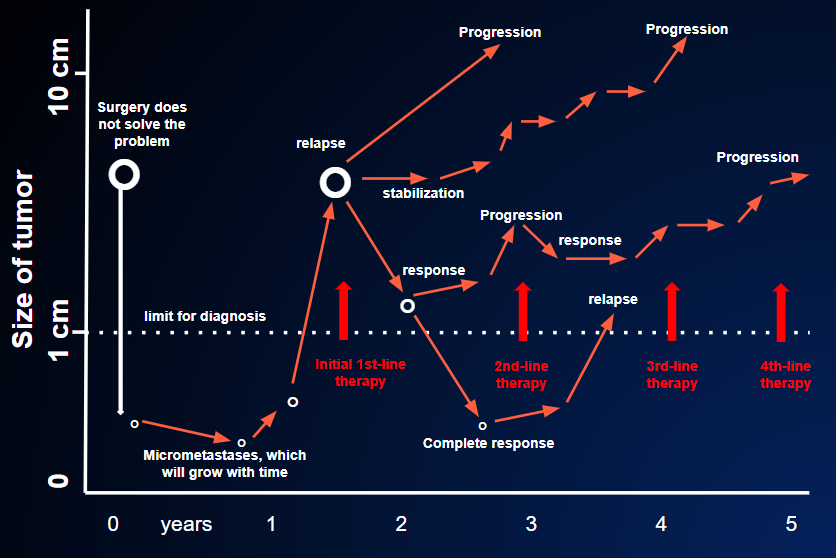This is the time of one of the most difficult and saddest decisions for the doctor, the patient and his family members. It is the time when all the suffering caused by the cancer comes to a head in its clearest and most direct form. If we can no longer fight the disease because several lines of therapy have failed and the tumor has grown to a critical size (10 cm or more), the hope of remaining alive is reduced to a minimum. However, we must be very careful not to aggravate the situation by stubbornly trying further anti-cancer treatments when they are no longer recommended; this will only cause the patient further suffering and accelerate his end.
It is the doctor’s task to decide whether administering further anti-cancertreatment constitutes “therapeutic stubbornness”, and when not making “one more attempt” would mean abandoning therapies that may still be useful. And the patient and his loved ones must understand and trust in these decisions.
There are situations in which the balance between the benefits and the side-effects of treatment is clearly and undoubtedly negative. This situation may arise:
- a few months after treatment in which several lines of therapy have been exhausted in rapid succession, or
- at the end of a long and relatively serene pathway marked by good responses to therapy, very long periods of normal life of good quality, and few moments of suffering and discomfort due to the side-effects of the therapy or to the symptoms caused by the progression of the disease, FIGURE 17.

In other cases, this negative balance between side-effects and benefits may be apparent right from the beginning; when the cancer is first discovered, it may already be so aggressive, widespread and massive (of large size) that therapy would not offer any real hope of improvement, but would only be very dangerous. (HOW IS IT POSSIBLE? HE/SHE WAS WELL AND NOW THEY SAY THERE’S NOTHING MORE THEY CAN DO)
When the balance between benefits and side-effects is clearly negative, it is decidedly wrong to administer further anti-cancer therapy. Unfortunately, in such situations, doctors often say, “There’s nothing more we can do”. From the point of view of fighting the cancer, this is true.
Nevertheless, it should always be pointed out that, although no further anti-cancer treatment can be recommended, there is still a lot that can be done to help the patient in terms of supportive therapies, even right up to the very end.
In these very difficult moments, the question of how much time is left is often asked. This question is extremely difficult to answer. (CAN WE PREDICT HOW MUCH TIME IS LEFT?) The end can be predicted with some reliability only when the patient’s life expectancy is of a few days or 1-2 weeks. Indeed, it is very difficult to estimate that she has, say, 3-4 months left, as this period may vary to a great extent. As long as the patient is able to attend the outpatient department and is not forced to spend the whole day in bed, with serious impairment of the vital organs, we cannot say that she is “terminal”.
